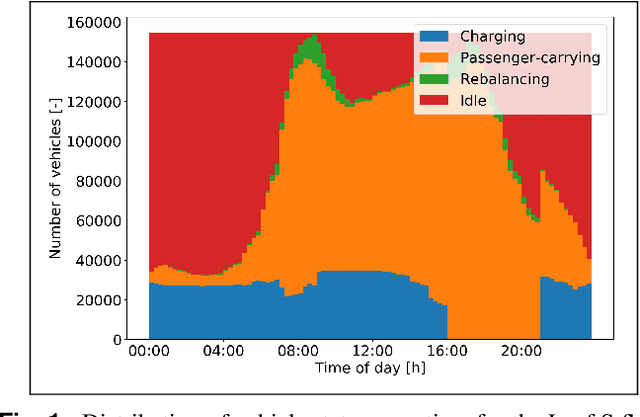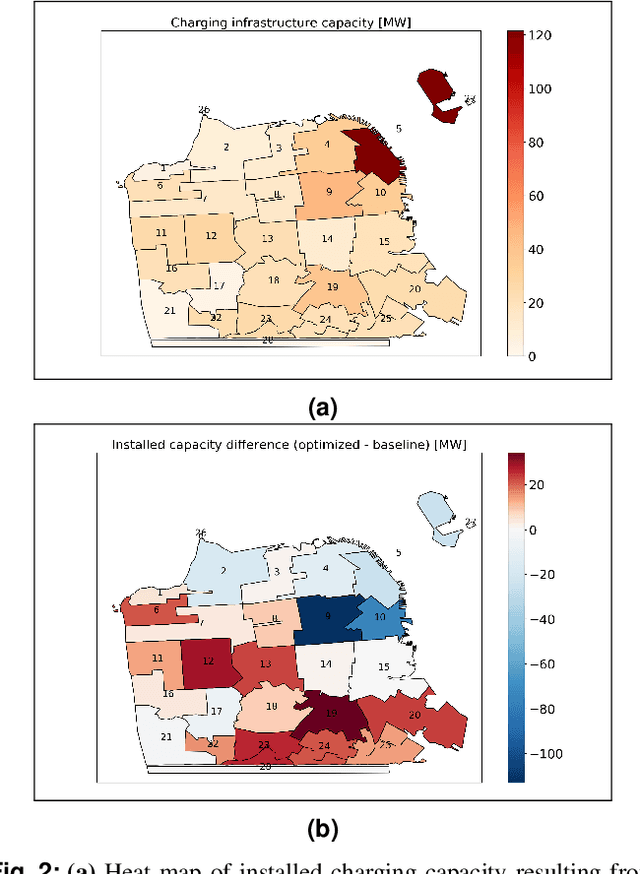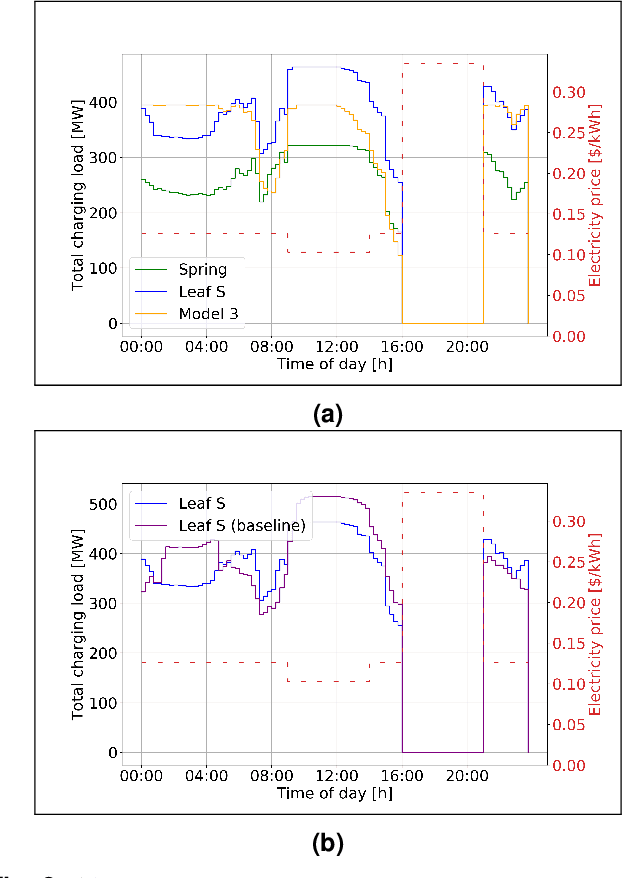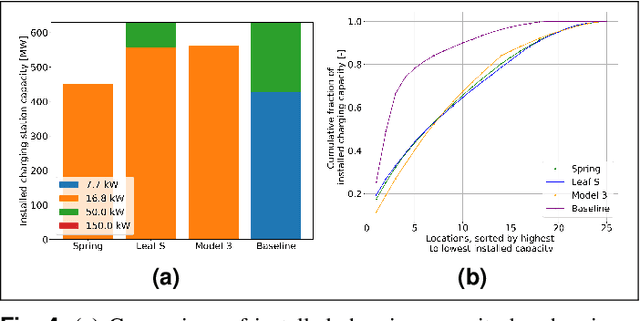Mauro Salazar
A Data-driven Pricing Scheme for Optimal Routing through Artificial Currencies
Nov 27, 2022Abstract:Mobility systems often suffer from a high price of anarchy due to the uncontrolled behavior of selfish users. This may result in societal costs that are significantly higher compared to what could be achieved by a centralized system-optimal controller. Monetary tolling schemes can effectively align the behavior of selfish users with the system-optimum. Yet, they inevitably discriminate the population in terms of income. Artificial currencies were recently presented as an effective alternative that can achieve the same performance, whilst guaranteeing fairness among the population. However, those studies were based on behavioral models that may differ from practical implementations. This paper presents a data-driven approach to automatically adapt artificial-currency tolls within repetitive-game settings. We first consider a parallel-arc setting whereby users commute on a daily basis from a unique origin to a unique destination, choosing a route in exchange of an artificial-currency price or reward while accounting for the impact of the choices of the other users on travel discomfort. Second, we devise a model-based reinforcement learning controller that autonomously learns the optimal pricing policy by interacting with the proposed framework considering the closeness of the observed aggregate flows to a desired system-optimal distribution as a reward function. Our numerical results show that the proposed data-driven pricing scheme can effectively align the users' flows with the system optimum, significantly reducing the societal costs with respect to the uncontrolled flows (by about 15% and 25% depending on the scenario), and respond to environmental changes in a robust and efficient manner.
Joint Optimization of Autonomous Electric Vehicle Fleet Operations and Charging Station Siting
Jul 21, 2021



Abstract:Charging infrastructure is the coupling link between power and transportation networks, thus determining charging station siting is necessary for planning of power and transportation systems. While previous works have either optimized for charging station siting given historic travel behavior, or optimized fleet routing and charging given an assumed placement of the stations, this paper introduces a linear program that optimizes for station siting and macroscopic fleet operations in a joint fashion. Given an electricity retail rate and a set of travel demand requests, the optimization minimizes total cost for an autonomous EV fleet comprising of travel costs, station procurement costs, fleet procurement costs, and electricity costs, including demand charges. Specifically, the optimization returns the number of charging plugs for each charging rate (e.g., Level 2, DC fast charging) at each candidate location, as well as the optimal routing and charging of the fleet. From a case-study of an electric vehicle fleet operating in San Francisco, our results show that, albeit with range limitations, small EVs with low procurement costs and high energy efficiencies are the most cost-effective in terms of total ownership costs. Furthermore, the optimal siting of charging stations is more spatially distributed than the current siting of stations, consisting mainly of high-power Level 2 AC stations (16.8 kW) with a small share of DC fast charging stations and no standard 7.7kW Level 2 stations. Optimal siting reduces the total costs, empty vehicle travel, and peak charging load by up to 10%.
Scalable and Congestion-aware Routing for Autonomous Mobility-on-Demand via Frank-Wolfe Optimization
Mar 08, 2019



Abstract:We consider the problem of vehicle routing for Autonomous Mobility-on-Demand (AMoD) systems, wherein a fleet of self-driving vehicles provides on-demand mobility in a given environment. Specifically, the task it to compute routes for the vehicles (both customer-carrying and empty travelling) so that travel demand is fulfilled and operational cost is minimized. The routing process must account for congestion effects affecting travel times, as modeled via a volume-delay function (VDF). Route planning with VDF constraints is notoriously challenging, as such constraints compound the combinatorial complexity of the routing optimization process. Thus, current solutions for AMoD routing resort to relaxations of the congestion constraints, thereby trading optimality with computational efficiency. In this paper, we present the first computationally-efficient approach for AMoD routing where VDF constraints are explicitly accounted for. We demonstrate that our approach is faster by at least one order of magnitude with respect to the state of the art, while providing higher quality solutions. From a methodological standpoint, the key technical insight is to establish a mathematical reduction of the AMoD routing problem to the classical traffic assignment problem (a related vehicle-routing problem where empty traveling vehicles are not present). Such a reduction allows us to extend powerful algorithmic tools for traffic assignment, which combine the classic Frank-Wolfe algorithm with modern techniques for pathfinding, to the AMoD routing problem. We provide strong theoretical guarantees for our approach in terms of near-optimality of the returned solution.
On the Interaction between Autonomous Mobility-on-Demand and Public Transportation Systems
Sep 05, 2018



Abstract:In this paper we study models and coordination policies for intermodal Autonomous Mobility-on-Demand (AMoD), wherein a fleet of self-driving vehicles provides on-demand mobility jointly with public transit. Specifically, we first present a network flow model for intermodal AMoD, where we capture the coupling between AMoD and public transit and the goal is to maximize social welfare. Second, leveraging such a model, we design a pricing and tolling scheme that allows to achieve the social optimum under the assumption of a perfect market with selfish agents. Finally, we present a real-world case study for New York City. Our results show that the coordination between AMoD fleets and public transit can yield significant benefits compared to an AMoD system operating in isolation.
 Add to Chrome
Add to Chrome Add to Firefox
Add to Firefox Add to Edge
Add to Edge